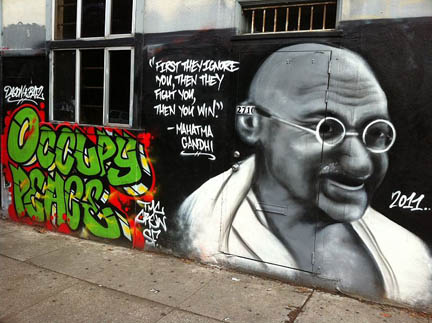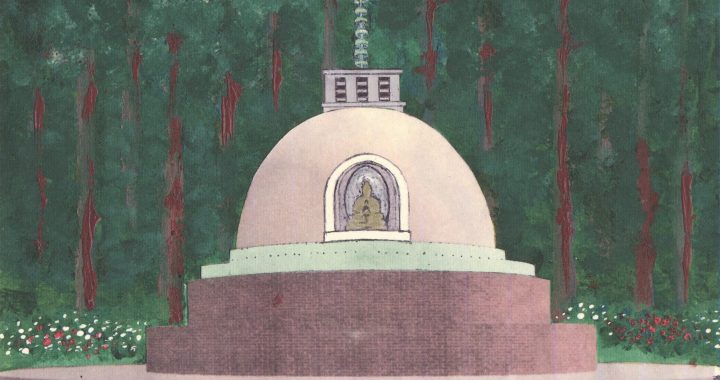Today is the International Day of Nonviolence (and YES, it’s pretty ironic, considering the tremendous amount of violence around the world)!!!
The International Day of Nonviolence (initiated by the United Nations) is observed each year on October 2nd, the birthday of Mahatma Gandhi, leader of the Indian independence movement and pioneer of the philosophy and strategy of non-violence, and is an occasion to “disseminate the message of non-violence, including through education and public awareness”. The resolution reaffirms “the universal relevance of the principle of non-violence” and the desire “to secure a culture of peace, tolerance, understanding and non-violence”.
In a world awash with violence (that certainly is NOT working), we need to immerse ourselves in the study and practice of nonviolence (EVERY DAY) and become emisaries of a revolutionary, alternative nonviolent path to a better world. Today, I share Father John Dear’s thoughtful essay on Ground Zero Center for Nonviolent Action co-founder Jim Douglass’ journey through the study and practice of nonviolence.
May we (to quote Fr. Dear) “choose the lightning fire of nonviolence and shed the light of peace on our war-torn world.
Leonard Eiger
On behalf of all of us at Ground Zero Center for Nonviolent Action
*************
Jim Douglass and the Lightning Fire of Nonviolence
by John Dear: On the Road to Peace
Originally published in Fr. John Dear’s blog (johndear.org)
To study the theological basis for Gospel nonviolence, there’s no better place to start than the groundbreaking works of my friend Jim Douglass — The Nonviolent Cross, Resistance and Contemplation, Lightning East to West, and The Nonviolent Coming of God.
I consider Jim the greatest theologian of nonviolence in the world. But his books have been out of print for decades — until now. A new publishing house, Wipf and Stock, set up by a small Christian community in Oregon, has just opened with the mission of republishing classic works of theology, including textbooks on liberation theology, all the writings of William Stringfellow and now all four of Jim’s classic works. I urge everyone to order Jim’s books. His message and wisdom are as urgent as ever. Few theologians make so clear the links between the spiritual life, the scriptures, the church and the hidden ground of nonviolence.
Jim makes the links so clear on paper because he has made them clear all his life. During the 1960s, he and Dorothy Day lobbied the bishops of the Second Vatican Council to write against weapons of mass destruction. He taught a spell at Notre Dame, and then founded the Ground Zero anti-nuclear campaign at the Trident Sub base near Seattle.
These days, he and his wife Shelley run Mary’s House, a Catholic Worker house of hospitality in Birmingham, Ala. He has spent the last decade working on a series of forthcoming books about the assassinations of JFK, Malcolm X, Martin King and RFK.
But his seminal study, The Nonviolent Cross, written during the crucible year of 1968, best tells the tale of nonviolence. The book begins with a sentence to unhinge everything. “To see reality in our time is to see the world as crucifixion.” Thus buttonholed, the reader at the outset faces a crisis — to bear up under reality or not. Untold numbers took up the challenge and plowed ahead. That book alone inspired thousands to take up the cross of nonviolent resistance against the war in Indochina.
“The logic of nonviolence is the logic of crucifixion and leads the person of nonviolence into the heart of the suffering Christ,” Jim writes.
The purpose of nonviolence is to move the oppressors to perceive as human beings those whom they are oppressing. People commit acts of violence and injustice against others only to the extent that they do not regard them as fully human. Nonviolent resistance seeks to persuade the aggressor to recognize in the victim the humanity they have in common, which when recognized fully makes violence impossible.
This goal of human recognition is sought through the power of voluntary suffering, by which the victim becomes no longer a victim but instead an active opponent in loving resistance to the one who has refused to recognize that victim as human. The person of nonviolence acts through suffering love to move the unjust opponent to a perception of their common humanity, and thus to the cessation of violence in the commencement of brother and sisterhood. The greater the repression, the greater must be the suffering courted by its victims; the greater the inhumanity, the greater the power of suffering love necessary to begin restoring the bonds of community. Suffering as such is powerless. Love transforms it into the kind of resistance capable of moving an opponent to the act of mutual recognition.
In Resistance and Contemplation, Jim explores the witness of direct nonviolent action. The examples upon which he draws are Jesus, who marched on the Temple, Gandhi, who picked up salt to declare India’s independence, and the Berrigans, who napalmed draft files in Catonsville, Maryland, to protest the U.S. war in Vietnam. Beneath such actions, says Jim, lay the voluntary embrace of powerlessness — long-suffering love, acceptance of pain, detachment in the face of prison and death. Such in a violent world become politically and spiritually “explosive.”
His other book, The Nonviolent Coming of God, explores the eschatology of nonviolence. Gandhi said that the day everyone practices nonviolence is the day God will reign on earth as in heaven. Jim compares the first- century destruction of Jerusalem — the virtual end of the world — with the nuclear menace of the 21st century — a potential end more literal. Only transforming nonviolence can keep the end from being inevitable.
In Lightning East to West Jim writes of his Ground Zero campaign to disarm a Trident sub base.
We live in that final time which offers humans the clearest choice in history: the kingdom or the holocaust. Either end is a lightning east to west: the nuclear holocaust a lightning fire, the kingdom of Reality a lightning spirit. We will choose lightning east to west today as either nuclear fire or the kingdom of God, as either despair and annihilation or transformation through nonviolence. If we look to Jesus and Gandhi, and what they point to, we can hope to choose the lightning fire of nonviolence.
Jim pursues what Thomas Merton called “an ontology of nonviolence” — the quest to put flesh on nonviolence, to give expression to the nature of its being. The quest is at first necessarily mystical, nonviolence being so alien to our species. In the words of Merton, “Everything is emptiness and everything is compassion.”
But Jim urges us on and guides us deep into the spirituality that disarms hearts and nations. “In our resistance to humankind’s destruction, we need to live and act in that spirit of ultimate perfect emptiness and compassion if we are to experience a way of transformation.” This is what he and Shelley have done at Ground Zero, what we try to do at Los Alamos, and what others try in their efforts to disarm the School of Americas, the Oak Ridge Base in Tennessee, and Livermore Labs in California.
“We are invited into acts of ultimate perfect emptiness and compassion in the places of total destruction of life on earth. If we can journey to those worldly places of power and destruction like Jesus and Gandhi, we can transform the darkness with the light of peace.”
I hope and pray with Jim that we’ll choose the lightning fire of nonviolence and shed the light of peace on our war-torn world.
You can learn about John Dear’s books at his website. To order Jim Douglass’ earlier books, contact: www.wipfandstock.com.




